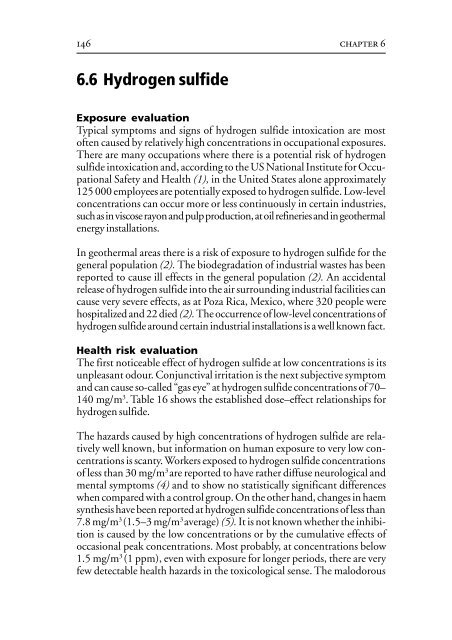Air Quality Guidelines - World Health Organization Regional Office ...
Air Quality Guidelines - World Health Organization Regional Office ...
Air Quality Guidelines - World Health Organization Regional Office ...
You also want an ePaper? Increase the reach of your titles
YUMPU automatically turns print PDFs into web optimized ePapers that Google loves.
146 chapter 6<br />
6.6 Hydrogen sulfide<br />
Exposure evaluation<br />
Typical symptoms and signs of hydrogen sulfide intoxication are most<br />
often caused by relatively high concentrations in occupational exposures.<br />
There are many occupations where there is a potential risk of hydrogen<br />
sulfide intoxication and, according to the US National Institute for Occupational<br />
Safety and <strong>Health</strong> (1), in the United States alone approximately<br />
125 000 employees are potentially exposed to hydrogen sulfide. Low-level<br />
concentrations can occur more or less continuously in certain industries,<br />
such as in viscose rayon and pulp production, at oil refineries and in geothermal<br />
energy installations.<br />
In geothermal areas there is a risk of exposure to hydrogen sulfide for the<br />
general population (2). The biodegradation of industrial wastes has been<br />
reported to cause ill effects in the general population (2). An accidental<br />
release of hydrogen sulfide into the air surrounding industrial facilities can<br />
cause very severe effects, as at Poza Rica, Mexico, where 320 people were<br />
hospitalized and 22 died (2). The occurrence of low-level concentrations of<br />
hydrogen sulfide around certain industrial installations is a well known fact.<br />
<strong>Health</strong> risk evaluation<br />
The first noticeable effect of hydrogen sulfide at low concentrations is its<br />
unpleasant odour. Conjunctival irritation is the next subjective symptom<br />
and can cause so-called “gas eye” at hydrogen sulfide concentrations of 70–<br />
140 mg/m 3 . Table 16 shows the established dose–effect relationships for<br />
hydrogen sulfide.<br />
The hazards caused by high concentrations of hydrogen sulfide are relatively<br />
well known, but information on human exposure to very low concentrations<br />
is scanty. Workers exposed to hydrogen sulfide concentrations<br />
of less than 30 mg/m 3 are reported to have rather diffuse neurological and<br />
mental symptoms (4) and to show no statistically significant differences<br />
when compared with a control group. On the other hand, changes in haem<br />
synthesis have been reported at hydrogen sulfide concentrations of less than<br />
7.8 mg/m 3 (1.5–3 mg/m 3 average) (5). It is not known whether the inhibition<br />
is caused by the low concentrations or by the cumulative effects of<br />
occasional peak concentrations. Most probably, at concentrations below<br />
1.5 mg/m 3 (1 ppm), even with exposure for longer periods, there are very<br />
few detectable health hazards in the toxicological sense. The malodorous

















